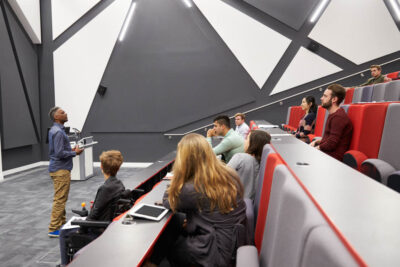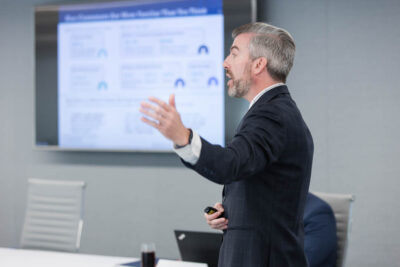How community college leaders can kickstart innovation on campus
Across hundreds of conversations with college leaders, the most interesting stories I’ve heard are never the ones about balancing budgets or raising money—instead, they’re about riding a motorcycle across the country to raise awareness about the quality of a two-year education, or turning parking lot security booths into “drive-up” advising offices. In large part, every leader’s job is to create an ambitious vision for the future, and lead the charge to attain it.
However, at cash-strapped institutions especially, the prospect of leading and executing a visionary plan for the future can feel daunting, if not impossible; it’s hard to focus on innovation when you’re mired in fundraising, budgets, and resource allocation decisions. But today’s community colleges have no choice but to be innovative to compete for scarcer high school graduates who have an expanding array of other options.
Today’s students demand more from their higher education experience, and the institutions that can meet these needs will win enrollments and engage students through graduation.
Three design thinking principles to kickstart campus innovation
When our dedicated consultants lead change management engagements for members of Navigate360, they typically find that college leaders have the resources they need to make transformational change happen: their students, their staff, and their own influence on campus. The bigger question is how leaders can leverage these resources productively to make holistic improvements to the institution.
This is where a design thinking framework can inspire and lead innovation. Why design thinking? The approach is low cost and inclusive of diverse opinions, which aligns well with the budget realities and the collaborative culture found at most, if not all, community colleges.
At its core, design thinking is an approach to innovation that relies on three key tenets of problem solving:
- Inspiration, or understanding people’s needs
- Ideation, or employing technology where appropriate
- Implementation, or making ideas a reality within resource constraints
1. Inspiration: What do students need?
For most college leaders, student feedback is a virtually unlimited resource: scan social media channels, read course surveys, or just request a short meeting and you’ll quickly realize how different the student perspective is from an administrator’s.
We certainly found this to be true in our research on student success in the community college setting. After interviewing hundreds of students across the country about their barriers to completion, we found that most students’ biggest mistakes (e.g., choosing the wrong major, picking an inconvenient schedule) had their origins in an onboarding process that resembled a game of Chutes and Ladders.
And we verified what they told us—over the last two summers, my research colleagues and I conducted over 50 onsite visits to campuses across the country leading “secret shopping” exercises where we went through the enrollment experience ourselves. Across institutions of varying sizes, locations, and student populations, we found no shortage of opportunities for improvement—any student at any institution has a grievance to share, and collectively these should serve as inspiration for transformational change.
At the beginning of a new change management engagement with SSC–Navigate members, our dedicated consultants help staff create a process map to uncover the greatest pain points students face in the enrollment process. In this exercise, members of the student service team outline all of the steps students must take to get from application to enrollment—and the result is far from streamlined or linear.
At Nashua Community College, this initial process mapping exercise revealed four major obstacles to timely student enrollment. Many of our members emerge with even longer lists—and a new appreciation for the process students complete before the first day of class.
The first step to understanding what students need from the institution is to ask: What are your goals at this college, and what is preventing you from achieving those goals? As you do this, it is equally important to adopt the student perspective to build empathy, fill in gaps, and uncover challenges that may be hidden even to students.
Get Started with our Student Intake Focus Group Guide
2. Ideation: How can we create the right solution?
It’s hard enough for college leaders to identify the real barriers to student success, but finding solutions can be even more difficult. The best advice to remember is that “perfect is the enemy of the good”—rather than strive for the ”best” solution, work with your team to first develop a basic solution that addresses the problem at hand. This can be a useful starting point to test with students and staff before investing in further development.
Consider the challenge of increasing financial aid reapplication rates at your institution: after surveying students who withdraw before earning a degree, an institution finds that the students fell into financial difficulty and couldn’t afford tuition in addition to their day-to-day expenses. Focus groups reveal that most of these students were financial aid eligible, but they did not submit a new FAFSA form every year and therefore lost the support. How do we convince continuing students to resubmit the FAFSA every year?
If the institution skips the ideation phase, they risk investing a lot of money in their first idea: a promotional campaign that reminds students to resubmit their FAFSA at the beginning of each semester. The campaign could cost several hundred dollars to produce paper flyers, banners, and events—and ultimately have few results to show for it.
Why? The message may not resonate with students, the materials may not be placed in the right areas on campus, or perhaps students don’t trust financial aid information when it’s delivered via mass marketing. Soliciting feedback from testing groups would have steered the institution in the right direction, and could have saved the cost of a full-scale campaign.
We’ve found that that it’s best to ideate with staff from across the institution, with special invitations to those with varied work experiences outside of higher education. It’s impossible to build for higher education without understanding higher education, of course, but it’s also impossible to innovate without exploring lessons learned from other institutions or industries. Strike a balance by inviting a diverse representation of staff to a brainstorming session.
3. Implementation: What are the resource constraints to realizing our vision?
EAB research has found several examples of innovative MBA programs that have placed big bets on design thinking. These programs may augment their curricular offerings with design thinking elements or even build new degree programs dedicated entirely to design thinking in the public and private sectors. The alignment between design thinking and business is most obvious in the implementation step, where the creativity of the innovation and ideation stages must be limited by the realities of available resources, whether that’s time, effort, or money.
Engage leaders from campus finance, technology, and operations offices early and often, perhaps including them in the inspiration and ideation stages of the innovation process as a way of gathering diverse perspectives. Most important, however, is to seek their counsel, rather than “yes” or “no” answers to feasibility questions.
Don’t ask, “Will this work?” Instead ask, “How do we make this work?” If you uncover ideas that solve major institutional challenges and resonate with students, it’s worth exploring all possible options to bring the idea to life at your institution.
More Blogs

Fixing What’s Broken in Interdisciplinary Program Design

What higher ed can learn from these successful academic program revitalizations
